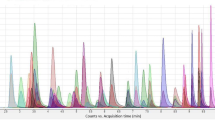Abstract
Benzylpiperazine (BZP) is an amphetamine-type stimulant, which was legally available in New Zealand and widely used in “Party Pills” until reclassification as a Class C drug in April 2008. BZP was included as part of a multi-analyte method developed for hair screening using high-performance liquid chromatography triple quadrupole mass spectrometry (LC-MS/MS). A 20-mg sample of hair is extracted and partially purified using mixed-mode solid-phase extraction cartridges prior to analysis by LC-MS/MS. The method was developed as a broad screen for drugs of abuse (including amphetamines, opiates, and benzodiazepines), with only the BZP results being presented here. The assay was validated and found to be linear over the range of 0.085 to 8.65 ng/mg with correlation coefficient of r 2 ≥ 0.99. Blank hair samples spiked with BZP at 0.22 and 2.16 ng/mg gave intra- and inter-day precision coefficients of variation of ≤10% (n = 6 per day, 3 days) at both levels and calculated extraction efficiencies of 78% and 91%, respectively. The results from the samples submitted to the laboratory for BZP analysis showed 11% were positive (n = 126). The mean BZP level was 3.9 ng/mg (range, 0.4–33 ng/mg; the result was extrapolated when above the calibration). These data are the first available showing the levels expected from users of BZP.

Distribution of BZP in hair (ng/mg) from 14 positive hair samples, using LC-MS/MS detection


Similar content being viewed by others
References
Wilkins C, Girling M, Sweetsur P, Huckle T, Haukau J (2006) Legal party pill use in New Zealand: Prevalence of use, availability, health harms and ‘gateway effects’ of benzylpiperazine (BZP) and trifluorophenylmethylpiperazine (TFMPP). Massey University, Auckland: Centre for Social and Health Outcomes Research (SHORE). Available at: [http://www.shore.ac.nz/projects/Legal%20party%20pills%20in%20New%20Zealand%20report3.pdf] (accessed on: March 2011)
Wilkins C, Sweetsur P, Girling M (2008) Patterns of benzylpiperazine/trifluoromethylphenylpiperazine party pill use and adverse effects in a population sample in New Zealand. Drug Alcohol Rev 27:633–639
Maurer HH, Kraemer T, Springer D, Staack RF (2004) Chemistry, pharmacology, toxicology, and hepatic metabolism of designer drugs of the amphetamine (ecstasy), piperazine, and pyrrolidinophenone types: a synopsis. Ther Drug Monit 26(2):127–131
Society of Hair Testing (2004) Recommendations for hair testing in forensic cases. Forensic Sci Int 145(2–3):83–84
Guthery B, Bassindale T, Bassindale A, Pillinger CT, Morgan GH (2010) Qualitative drug analysis of hair extracts by comprehensive two-dimensional gas chromatography/time-of-flight mass spectrometry. J Chromatogr A 1217(26):4402–4410. doi:10.1016/j.chroma.2010.04.020
Barroso M, Costa S, Dias M, Vieira DN, Queiroz JA, Lopez-Rivadulla M (2010) Analysis of phenylpiperazine-like stimulants in human hair as trimethylsilyl derivatives by gas chromatography-mass spectrometry. J Chromatogr A 1217(40):6274–6280. doi:10.1016/j.chroma.2010.08.001
Tsanaclis L, Wicks JF (2008) Differentiation between drug use and environmental contamination when testing for drugs in hair. Forensic Sci Int 176(1):19–22
Nolan S (2008) Drug-free workplace programmes: New Zealand perspective. Forensic Sci Int 174(2–3):125–132
Tsanaclis L, Wicks JF (2007) Patterns in drug use in the United Kingdom as revealed through analysis of hair in a large population sample. Forensic Sci Int 170(2–3):121–128
Lee S, Han E, Park Y, Choi H, Chung H (2009) Distribution of methamphetamine and amphetamine in drug abusers’ head hair. Forensic Sci Int 190(1–3):16–18. doi:10.1016/j.forsciint.2009.05.004
Acknowledgments
The authors thank the analytical team in the Specialized Analytical Services group of ESR.
Author information
Authors and Affiliations
Corresponding author
Rights and permissions
About this article
Cite this article
Bassindale, T.A., Berezowski, R. Quantitative analysis of hair samples for 1-benzylpiperazine (BZP) using high-performance liquid chromatography triple quadrupole mass spectrometry (LC-MS/MS) detection. Anal Bioanal Chem 401, 2013–2017 (2011). https://doi.org/10.1007/s00216-011-5235-5
Received:
Revised:
Accepted:
Published:
Issue Date:
DOI: https://doi.org/10.1007/s00216-011-5235-5




